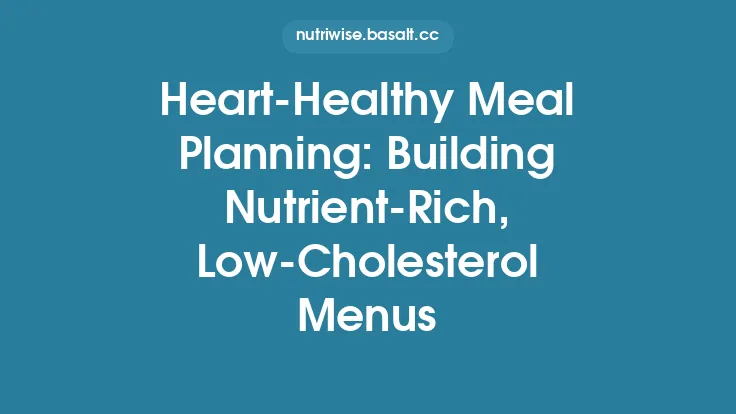Whole‑food nutrition is the most reliable foundation for safeguarding against micronutrient shortfalls. By selecting foods that are naturally rich in vitamins and minerals—and combining them in ways that enhance absorption—you can construct a meal plan that consistently delivers the nutrients your body needs, without relying on supplements or fortified products. This approach not only supports optimal physiological function but also aligns with sustainable eating patterns that are enjoyable and adaptable over the long term.
Understanding Micronutrient Density in Whole Foods
Micronutrient density refers to the amount of vitamins and minerals present per unit of energy (calories) or per gram of edible portion. Foods that score high on this metric provide a larger nutritional return for the same caloric intake, making them ideal building blocks for a deficiency‚Äëresistant diet.
| Food Category | Typical Micronutrient Highlights (per 100‚ÄØg) | Micronutrient Density Score* |
|---|---|---|
| Dark leafy greens (e.g., kale, spinach) | Vitamin K ≈ 500 µg, Vitamin A ≈ 9 000 IU, Folate ≈ 140 µg, Calcium ≈ 150 mg | 9.2 |
| Organ meats (e.g., liver) | Vitamin A ≈ 20 000 IU, Vitamin B12 ≈ 70 µg, Iron ≈ 6 mg, Copper ≈ 12 mg | 8.7 |
| Shellfish (e.g., oysters) | Zinc ≈ 7 mg, Selenium ≈ 70 µg, Vitamin B12 ≈ 20 µg, Iron ≈ 5 mg | 8.3 |
| Nuts & seeds (e.g., pumpkin seeds) | Magnesium ≈ 400 mg, Zinc ≈ 7 mg, Vitamin E ≈ 35 mg, Copper ≈ 1.5 mg | 7.5 |
| Legumes (e.g., lentils) | Folate ≈ 180 µg, Iron ≈ 3 mg, Magnesium ≈ 36 mg, Potassium ≈ 370 mg | 7.0 |
| Fatty fish (e.g., salmon) | Vitamin D ≈ 15 µg, Selenium ≈ 30 µg, Omega‑3 ≈ 2 g, Iodine ≈ 30 µg | 6.8 |
\*Score is a composite of the top five micronutrients per 100‚ÄØg, weighted by Recommended Dietary Allowance (RDA) percentages. Higher scores indicate greater overall micronutrient provision relative to caloric content.
When constructing a meal plan, prioritize items from the top‚Äëscoring rows. Their high nutrient-to-calorie ratios mean you can meet micronutrient targets without excessive energy intake.
Core Food Groups that Provide Key Micronutrients
- Leafy Greens & Brassicas – Rich in vitamin K, vitamin C, folate, calcium, and a suite of phytonutrients.
- Organ Meats & Off‑Cuts – Concentrated sources of vitamin A, B‑complex vitamins (especially B12), iron, copper, and zinc.
- Seafood (Shellfish & Fatty Fish) – Provide iodine, selenium, zinc, vitamin D, and omega‑3 fatty acids.
- Legumes & Pulses – Offer folate, iron (non‑heme), magnesium, and resistant starch.
- Nuts & Seeds – Supply magnesium, vitamin E, copper, and healthy fats that aid fat‑soluble vitamin absorption.
- Whole Grains – Contain B‑vitamins, iron, zinc, and trace minerals; also provide dietary fiber that supports gut health, indirectly influencing nutrient absorption.
- Root Vegetables & Squash – Provide potassium, vitamin A (beta‑carotene), and vitamin C.
By ensuring each meal contains at least one item from three or more of these groups, you create a “micronutrient matrix” that covers a broad spectrum of essential vitamins and minerals.
Building Balanced Meals – The Micronutrient Matrix
A practical way to visualize nutrient coverage is to map each food onto a matrix of micronutrient families (e.g., fat‚Äësoluble vitamins, water‚Äësoluble B‚Äëvitamins, trace minerals). Below is a template you can adapt:
| Meal Component | Vitamin‚ÄØA | Vitamin‚ÄØC | Vitamin‚ÄØD | Vitamin‚ÄØE | Vitamin‚ÄØK | B‚ÄëVitamins | Iron | Calcium | Magnesium | Zinc | Selenium |
|---|---|---|---|---|---|---|---|---|---|---|---|
| Dark leafy green (1 cup) | ✔︎ | ✔︎ | – | – | ✔︎ | B9, B6 | – | ✔︎ | – | – | – |
| Salmon (100 g) | – | – | ✔︎ | – | – | B12, B3 | – | – | – | – | ✔︎ |
| Lentils (½ cup cooked) | – | – | – | – | – | B1, B6, Folate | ✔︎ | – | ✔︎ | – | – |
| Pumpkin seeds (¼ cup) | – | – | – | ✔︎ | – | – | – | – | ✔︎ | ✔︎ | – |
| Orange (1 medium) | – | ✔︎ | – | – | – | – | – | – | – | – | – |
A “✔︎” indicates a meaningful contribution (≥ 10 % of the RDA per typical serving). When you assemble a plate, aim for a row of at least eight checkmarks across the matrix. This ensures a comprehensive micronutrient profile without over‑reliance on any single food.
Practical Meal‚ÄëPlanning Workflow
- Set Baseline Targets – Use the RDA values for your age, sex, and physiological status (e.g., pregnancy). Compile a spreadsheet listing each micronutrient and its target amount.
- Select Core Foods – Choose 12–15 whole foods that collectively cover > 80 % of the RDA for each micronutrient. Prioritize those with high density scores.
- Create a Weekly Template – Draft a 7‑day framework where each day includes:
- Breakfast: 1 fruit/vegetable + whole grain + protein (e.g., Greek yogurt, eggs, or tofu).
- Lunch: Leafy green base + protein (fish, legumes, or meat) + healthy fat (nuts, avocado, or olive oil).
- Dinner: Starchy vegetable or whole grain + protein + cruciferous side.
- Snacks: Micronutrient‚Äëdense options (e.g., roasted seaweed, nut butter on apple slices).
- Map Micronutrient Coverage – Input each planned dish into your spreadsheet; the software will sum contributions and flag any shortfalls. Adjust by swapping or adding foods.
- Batch‑Prep Staples – Cook large batches of legumes, grains, and roasted vegetables. Portion them into containers to streamline daily assembly.
- Review & Refine – At the end of the week, compare actual intake (via the spreadsheet) against targets. Tweak the next week’s plan to address any gaps.
Sample Weekly Meal Plan with Nutrient Highlights
| Day | Breakfast | Lunch | Dinner | Snack |
|---|---|---|---|---|
| Mon | Oatmeal (½ cup) + sliced kiwi + chia seeds (1 tbsp) | Kale salad with grilled chicken breast, quinoa (½ cup), pumpkin seeds (¼ cup), lemon‑olive‑oil dressing | Baked salmon (120 g) + roasted sweet potato (1 cup) + steamed broccoli | Handful of almonds |
| Tue | Whole‑grain toast (2 slices) + avocado (½) + poached egg (2) | Lentil soup (1 cup) + side of sautéed Swiss chard (1 cup) | Stir‑fried tofu (150 g) with bell peppers, bok choy, brown rice (½ cup) | Orange |
| Wed | Greek yogurt (¾ cup) + mixed berries (½ cup) + flaxseed (1 tbsp) | Sardine salad (canned sardines in water, 1 can) on mixed greens, cherry tomatoes, olives, olive oil | Beef liver pâté (50 g) on rye crackers + roasted carrots | Pumpkin seed trail mix |
| Thu | Smoothie: spinach (1‚ÄØcup), banana, fortified plant milk, hemp protein (2‚ÄØtbsp) | Chickpea‚Äëspinach curry (1‚ÄØcup) with basmati rice (¬Ω‚ÄØcup) | Grilled mackerel (120‚ÄØg) + quinoa tabbouleh (¬Ω‚ÄØcup) + roasted Brussels sprouts | Apple with almond butter |
| Fri | Scrambled eggs (2) with mushrooms and tomatoes + whole‑grain English muffin | Tuna‑nori roll (canned tuna, nori, cucumber, brown rice) | Lentil‑sweet‑potato shepherd’s pie (1 cup) topped with kale chips | Yogurt with honey |
| Sat | Buckwheat pancakes (2) topped with fresh berries + maple syrup | Turkey breast slices (100 g) + mixed greens, avocado, pumpkin seeds, vinaigrette | Baked cod (120 g) + millet (½ cup) + sautéed zucchini | Handful of walnuts |
| Sun | Millet porridge (½ cup) + dried apricots (¼ cup) + pumpkin seeds (1 tbsp) | Black‑bean burrito bowl: black beans (½ cup), brown rice (½ cup), corn, salsa, lettuce | Roast chicken thigh (120 g) + roasted root vegetables (carrots, parsnips) + steamed kale | Dark chocolate (≥ 70 % cacao) |
Nutrient Highlights
- Vitamin‚ÄØA: Sweet potatoes, kale, carrots, liver, and mangoes (in fruit).
- Vitamin‚ÄØC: Kiwi, bell peppers, broccoli, citrus, berries.
- Vitamin‚ÄØD: Fatty fish (salmon, mackerel, sardines).
- Vitamin‚ÄØE: Almonds, sunflower seeds, avocado, olive oil.
- Vitamin‚ÄØK: Leafy greens (kale, Swiss chard, spinach).
- B‚ÄëVitamins: Whole grains, legumes, eggs, liver, fish.
- Iron: Liver, lentils, spinach, beef, sardines (heme and non‚Äëheme sources).
- Calcium: Yogurt, fortified plant milk, kale, tofu (calcium‚Äëset).
- Magnesium: Pumpkin seeds, nuts, whole grains, legumes.
- Zinc: Pumpkin seeds, beef, oysters (if included), chickpeas.
- Selenium: Brazil nuts (1–2 per day), fish, whole grains.
Adjusting for Personal Preferences and Dietary Restrictions
- Vegetarian/Vegan: Replace animal‚Äëbased sources with fortified plant milks, tempeh, nutritional yeast (B12), and seaweed (iodine). Pair iron‚Äërich legumes with vitamin‚ÄØC‚Äërich foods to boost non‚Äëheme iron absorption.
- Gluten‚ÄëFree: Swap wheat‚Äëbased grains for quinoa, millet, buckwheat, or certified‚Äëgluten‚Äëfree oats. Ensure processed gluten‚Äëfree products are not overly refined, as they often lack micronutrient density.
- Low‚ÄëSodium: Use fresh herbs, citrus zest, and spices instead of salt. Choose low‚Äësodium canned beans or rinse them thoroughly.
- Low‚ÄëFODMAP: Opt for low‚ÄëFODMAP vegetables (e.g., carrots, zucchini, spinach) and protein sources while still maintaining micronutrient coverage.
When making substitutions, re‚Äërun the nutrient‚Äëcoverage spreadsheet to confirm that the overall matrix remains robust.
Cooking Techniques that Preserve Micronutrients
| Technique | Micronutrient Impact | Best‚ÄëPractice Tips |
|---|---|---|
| Steaming | Retains water‑soluble vitamins (C, B‑complex) better than boiling. | Steam vegetables just until tender‑crisp (3–5 min). |
| Quick Sauté | Preserves heat‑sensitive nutrients while allowing fat‑soluble vitamin absorption. | Use a small amount of extra‑virgin olive oil; avoid overheating (> 180 °C). |
| Roasting | Concentrates flavors; modest loss of vitamin C, but enhances beta‑carotene bioavailability. | Roast at 190–200 °C; coat with a thin oil layer to protect cell walls. |
| Fermentation | Increases bioavailability of B‑vitamins and minerals (e.g., sauerkraut, kimchi). | Include 1–2 servings of fermented vegetables per week. |
| Blanching | Short, high‚Äëheat exposure can inactivate antinutrients (oxalates) while preserving most nutrients. | Blanch leafy greens for 30‚ÄØs, then shock in ice water. |
| Slow Cooking | May degrade some heat‚Äësensitive vitamins but improves mineral extraction from bones and tough cuts. | Add a splash of acid (lemon juice) at the end to preserve vitamin‚ÄØC. |
Avoid prolonged boiling of vegetables in excess water, as this leaches water‚Äësoluble vitamins. If you do boil, reuse the cooking liquid in soups or sauces to reclaim lost nutrients.
Using Food Composition Data and Tools
- USDA FoodData Central – Comprehensive database with nutrient values for raw and cooked foods.
- NutritionData.Self.com – Provides nutrient density scores and visual “micronutrient radar” charts.
- Cronometer – Free app that tracks micronutrient intake against RDAs; allows custom food entry for home‑grown produce.
- Open Food Facts – Community‑sourced data for packaged foods; useful for verifying fortification levels (though the focus here is whole foods).
When entering data, select the *cooked* form that matches your preparation method (e.g., “broccoli, boiled, drained, no salt”). This ensures the nutrient values reflect realistic bioavailability.
Monitoring and Fine‚ÄëTuning Your Plan Over Time
Even with a well‚Äëdesigned whole‚Äëfood plan, periodic review is essential to maintain adequacy:
- Quarterly Spreadsheet Review – Export your weekly intake data, calculate average percentages of RDAs, and identify any nutrients consistently below 80 % of target.
- Seasonal Rotation – Introduce new produce as it becomes available to diversify phytonutrient profiles and prevent monotony.
- Cooking Method Audit – If you notice a trend of low vitamin C, assess whether boiling is over‑used and shift toward steaming or raw preparations.
- Feedback Loop – Note subjective energy levels, skin health, and mood; while not diagnostic, these can hint at subtle imbalances that warrant a tweak in food choices.
By treating the meal plan as a dynamic system rather than a static checklist, you ensure long‚Äëterm resilience against micronutrient deficiencies while enjoying a varied, flavorful diet.
Through deliberate selection of nutrient‑dense whole foods, strategic meal composition, and ongoing data‑driven adjustments, you can build a meal plan that consistently supplies the vitamins and minerals essential for optimal health—without the need for synthetic supplements or fortified processed foods. This evergreen framework empowers you to eat confidently, knowing each bite contributes to a robust micronutrient foundation.





